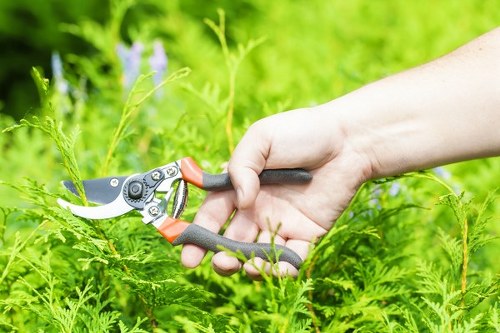Mastering Hedge Trimming in Victoria: A Comprehensive Guide
Introduction to Hedge Trimming

Hedge trimming is an essential aspect of maintaining the beauty and health of your garden. In Victoria, where the climate can be quite varied, understanding the best practices for hedge maintenance is crucial for homeowners and gardening enthusiasts alike.
Proper hedge trimming not only enhances the aesthetic appeal of your property but also promotes the growth and longevity of the plants. Whether you have a formal hedge or a more natural one, regular trimming ensures that your hedges remain lush and vibrant throughout the year.
Victoria’s diverse climate means that different types of hedges require different care routines. From the cool temperate regions to the warmer coastal areas, tailoring your hedge trimming approach to suit the local conditions can make a significant difference in the results.
Benefits of Regular Hedge Trimming

Regular hedge trimming offers numerous benefits, both for the appearance of your garden and the health of the plants. One of the primary advantages is the promotion of dense, bushy growth. By trimming back the outer branches, you encourage the plant to produce more foliage, leading to a fuller and more attractive hedge.
Another important benefit is the prevention of diseases and pests. Overgrown hedges can create a perfect environment for pests to thrive and for diseases to spread. Regular trimming helps to improve air circulation and reduce the chances of infestations, ensuring your hedges remain healthy and resilient.
Additionally, well-maintained hedges can provide better privacy by keeping the boundaries of your property clear and imposing. This is particularly important in suburban areas of Victoria where properties are in close proximity to one another.
Choosing the Right Tools for Hedge Trimming

Having the right tools is essential for effective hedge trimming. The choice of tools depends on the type and size of the hedges you are working with. For smaller hedges, hand shears or electric hedge trimmers might be sufficient. These tools offer precision and control, allowing you to make clean cuts without causing damage to the plant.
For larger or more robust hedges, gas-powered trimmers or pole pruners may be necessary. These tools can help you reach higher branches and handle thicker stems with ease. Investing in quality tools not only makes the trimming process more efficient but also ensures that you achieve the best possible results without harming the plants.
Maintaining your tools is equally important. Regular cleaning, sharpening, and proper storage will extend the life of your hedge trimmers and ensure they are always ready for use.
Best Time to Trim Hedges in Victoria

The timing of hedge trimming is crucial for the health and appearance of your hedges. In Victoria, the best time to trim hedges generally depends on the type of hedge you have. For most evergreen hedges, late winter or early spring is ideal. This timing allows the plants to recover and produce new growth during the growing season.
For deciduous hedges, trimming can be done in late autumn after the leaves have fallen. This helps to shape the hedge without disturbing the plant during its dormant period. Avoid trimming hedges during the peak of summer, as the intense heat can stress the plants and impede their ability to heal properly.
It's also important to consider the specific requirements of the hedge species you are working with. Some plants may have unique trimming schedules to optimize their growth and flowering cycles.
Step-by-Step Guide to Trimming Hedges

Trimming hedges can be a straightforward process when approached methodically. Here is a step-by-step guide to help you achieve professional-looking results:
- Assess the Hedge: Start by examining the overall shape and health of the hedge. Identify any dead or diseased branches that need to be removed.
- Choose the Right Tools: Select the appropriate trimming tools based on the size and type of your hedge.
- Trim the Top: Begin by trimming the top of the hedge to achieve the desired height. Make sure the top is slightly narrower than the base to allow sunlight to penetrate.
- Shape the Sides: Move on to the sides, trimming evenly to maintain a consistent shape. Use a string or a guide to ensure straight lines.
- Clean Up: Remove any trimmings and debris to keep the area tidy and prevent the spread of pests or diseases.
- Maintain Regularly: Schedule regular trimming sessions to keep your hedge in optimal condition throughout the year.
Common Mistakes to Avoid

While hedge trimming is relatively simple, there are common mistakes that homeowners often make. Avoiding these can help you maintain healthy and attractive hedges:
- Over-Trimming: Removing too much foliage at once can stress the plant and inhibit growth. Trim gradually and maintain a balanced shape.
- Ignoring Plant Health: Trimming healthy hedges without addressing underlying health issues can lead to larger problems. Always inspect for signs of disease or pests before trimming.
- Using Dull Tools: Dull trimming tools can cause ragged cuts, which can make the hedges more susceptible to infections. Ensure your tools are sharp and well-maintained.
- Trimming at the Wrong Time: Timing is critical for hedge trimming. Trimming at inappropriate times can disrupt the plant’s growth cycle and reduce its vitality.
Advanced Hedge Trimming Techniques

For those looking to take their hedge trimming skills to the next level, several advanced techniques can enhance the appearance and health of your hedges:
Heading Cuts
Heading cuts involve trimming the ends of branches to encourage denser growth. This technique is particularly effective for maintaining a formal shape and promoting a fuller appearance.
Thinning Cuts
Thinning cuts are used to remove entire branches or stems, which helps to open up the canopy and improve air circulation. This reduces the risk of disease and allows more light to reach the inner parts of the hedge.
Layered Trimming
Layered trimming involves cutting the hedge at different heights to create a tiered effect. This can add visual interest and complexity to your garden design.
Training the Hedge
Training involves guiding the growth of the hedge in a particular direction or pattern. Using supports or ties can help achieve specific shapes, such as arches or curves, enhancing the overall landscape.
Seasonal Care for Hedges

Different seasons bring different challenges and requirements for hedge care. Adapting your trimming routine to the changing seasons can ensure your hedges remain healthy and beautiful year-round.
Spring
In spring, focus on removing dead or damaged branches and shaping the hedge to encourage new growth. Applying a balanced fertilizer can support the plant’s development during the growing season.
Summer
During the summer months, regular watering and monitoring for pests or diseases are essential. Light trimming can help manage growth and prevent the hedge from becoming overgrown.
Autumn
Autumn is a good time to perform more substantial trimming before the winter. This helps to prepare the hedge for the colder months and ensures it remains strong and resilient.
Winter
In winter, minimal trimming is recommended. Focus on protecting the hedge from harsh weather conditions by mulching and ensuring proper drainage around the base.
Selecting the Right Hedge Plants for Victorian Gardens

Choosing the right type of hedge plant is fundamental to achieving the desired look and maintenance level for your garden. Victoria offers a wide range of hedge plants suited to its diverse climate zones.
Evergreen Hedges
Evergreen hedges, such as boxwood or privet, retain their foliage year-round, providing constant privacy and structure. They are ideal for creating formal boundaries and can be easily shaped through regular trimming.
Deciduous Hedges
Deciduous hedges, including hawthorn or beech, lose their leaves in the winter but offer vibrant color and seasonal interest. They are generally lower maintenance and can adapt well to different soil types.
Flowering Hedges
For added visual appeal, consider flowering hedges like roses or lilacs. These hedges not only serve as privacy screens but also provide beautiful blooms that can enhance the overall aesthetics of your garden.
Hybrid Varieties
Hybrid hedge plants offer the best of both worlds, combining the robustness of evergreens with the vibrant colors of flowering decedents. These varieties can be a great choice for those looking to add both durability and beauty to their hedges.
Eco-Friendly Hedge Trimming Practices

Adopting eco-friendly practices in hedge trimming not only benefits your garden but also contributes to environmental sustainability. Here are some ways to make your hedge trimming more eco-conscious:
- Use Electric or Manual Tools: Opt for electric or manual hedge trimmers over gas-powered ones to reduce carbon emissions and noise pollution.
- Compost Trimmings: Instead of disposing of hedge clippings, compost them to create nutrient-rich soil for your garden.
- Water Efficiently: Ensure that your hedges are watered efficiently, avoiding water wastage by using drip irrigation or watering during cooler parts of the day.
- Choose Native Plants: Native hedge plants are adapted to the local climate and soil conditions, requiring less water and fewer resources to maintain.
- Promote Biodiversity: Encourage a variety of plants within your hedges to support local wildlife and promote a healthy ecosystem.
Reducing Waste
Minimizing waste during hedge trimming can also have a positive environmental impact. By carefully planning your trimming activities and recycling plant materials, you contribute to a more sustainable gardening practice.
Organic Fertilizers
Using organic fertilizers instead of chemical ones helps maintain soil health and reduces the risk of harmful runoff into local waterways.
Professional Hedge Trimming Services in Victoria

While DIY hedge trimming can be rewarding, sometimes enlisting the help of professional services ensures the best results. Professional hedge trimmers in Victoria offer expertise and equipment that can handle complex trimming tasks efficiently.
Benefits of Hiring Professionals
- Expertise: Professionals have the knowledge to identify the best trimming techniques for different hedge types.
- Efficiency: With the right tools and experience, they can complete trimming tasks more quickly and effectively.
- Safety: Trimming high or thick hedges can be dangerous. Professionals are trained to handle such tasks safely.
- Customized Services: Professional services can tailor their approach to meet your specific garden design and maintenance needs.
Choosing the Right Service
When selecting a professional hedge trimming service in Victoria, consider factors such as their experience, customer reviews, and the range of services they offer. It’s important to choose a service that understands your vision for your garden and can execute it with precision.
Cost Considerations
The cost of professional hedge trimming varies based on the size and complexity of the job. While it may seem like an added expense, the quality and longevity of the results often justify the investment.
Scheduling and Frequency
Discuss with your chosen service the best scheduling intervals for maintaining your hedges. Regular professional trims can keep your hedges in top condition without the need for extensive DIY maintenance.
Maintaining Hedges Between Trims

Maintaining your hedges between trimming sessions is vital to ensure they stay healthy and vibrant. Simple daily or weekly care routines can significantly impact the overall condition of your hedges.
Watering Practices
Consistent watering is essential, especially during dry spells. Ensure your hedges receive enough moisture to thrive without becoming waterlogged. Using mulch around the base can help retain soil moisture and regulate temperature.
Fertilizing
Regular fertilization provides the necessary nutrients for your hedges to grow strong and healthy. Choose a fertilizer that suits the specific needs of your hedge plants and apply it according to the manufacturer’s instructions.
Pest and Disease Control
Monitor your hedges for signs of pests or diseases and take prompt action if any issues arise. Early detection and treatment can prevent minor problems from escalating into major threats to your hedge’s health.
Pruning Dead or Damaged Branches
Remove any dead or damaged branches as soon as you notice them. This not only maintains the appearance of your hedge but also prevents potential disease spread.
Regular Inspections
Conduct regular inspections of your hedges to catch any issues early. Look for changes in leaf color, unusual growth patterns, or signs of pest activity.
Innovative Hedge Trimming Trends in Victoria

Gardening trends continually evolve, and hedge trimming is no exception. Staying updated with the latest trends can help you keep your garden looking modern and stylish.
Topiary Art
Topiary involves shaping hedges into intricate and decorative forms, such as animals, geometric shapes, or abstract designs. This artistic approach adds a unique and personalized touch to your garden.
Minimalist Hedging
Less is more with minimalist hedging. Simple, clean lines and uncluttered shapes create a sophisticated and elegant look, making your garden appear more spacious and serene.
Mixed Hedging
Mixing different types of hedge plants can create a dynamic and visually appealing landscape. Combining various textures, colors, and heights adds depth and interest to your garden design.
Eco-Friendly Designs
Incorporating eco-friendly designs, such as using native plants or incorporating sustainable materials, aligns your garden maintenance practices with environmental conservation efforts.
Smart Gardening Tools
Advancements in gardening technology have introduced smart tools that can assist with hedge trimming. Automated trimmers and gardening apps help streamline the maintenance process and improve efficiency.
Conclusion

Hedge trimming in Victoria is more than just a gardening task; it’s an art that enhances the beauty and functionality of your outdoor space. By understanding the best practices, choosing the right tools, and staying informed about the latest trends, you can maintain lush and healthy hedges that complement your garden’s overall design.
Whether you opt for DIY trimming or hire professional services, regular maintenance is key to ensuring your hedges remain a stunning feature of your property year-round. Embrace the techniques and tips outlined in this guide to achieve the best possible results and enjoy a vibrant, well-maintained garden in Victoria.
Contact us today to schedule your hedge trimming service and transform your garden into a masterpiece.
Frequently Asked Questions

How often should I trim my hedges in Victoria?
The frequency of trimming depends on the type of hedge and its growth rate. Generally, evergreen hedges benefit from trimming two to three times a year, while deciduous hedges may only need trimming once a year.
What is the best time of year to trim hedges?
Late winter or early spring is ideal for most hedge trimming, allowing plants to recover and grow during the active growing season. Avoid trimming during extreme weather conditions.
Can I trim my hedges myself, or should I hire a professional?
If you have the right tools and experience, you can trim your hedges yourself. However, for large or complex hedges, hiring a professional ensures safety and optimal results.
What tools do I need for hedge trimming?
Essential tools include hedge shears or electric trimmers for smaller hedges, and pole pruners or gas-powered trimmers for larger ones. Ensure all tools are sharp and well-maintained.
How can I prevent pests and diseases in my hedges?
Regular trimming improves air circulation and reduces the risk of pests and diseases. Additionally, monitor your hedges regularly and address any issues promptly to maintain their health.
Ready to give your hedges the care they deserve? Book your service now and let our experts help you achieve a beautiful, well-maintained garden.
